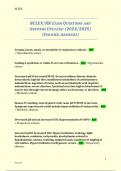NCLEX
NCLEX/RN EXAM QUESTIONS AND
ANSWERS UPDATED (2024/2025)
(VERIFIED ANSWERS)
Trauma, burns, sepsis, or metabolic or respiratory acidosis. - ANS
✓Hyperkalemia causes:
Cushing's syndrome or colitis & over use of laxatives. - ANS ✓Hypokalemia
causes:
Decreased pH & decreased HCO3. Occurs in kidney disease; diabetic
ketoacidosis; high fat diet; insufficient metabolism of carbohydrates;
malnutrition; ingestion of toxins, such as acetylsalicylic acid (aspirin);
malnutrition; severe diarrhea. Intestinal secretion high in bicarbonate &
may be lost through enteric drainage tubes, an ileostomy, or diarrhea. - ANS
✓Metabolic acidotic
Nausea & vomiting. Loss of gastric acid, cause pH & HCO3 to increase.
Symptoms experienced would include hypoventilation & tachycardia. - ANS
✓Metabolic alkalosis
Decreased pH and an increased CO2. Hypoventalation & COPD - ANS
✓Respiratory acidotic
Increased pH & decreased CO2. Hyperventilation, Lethargy, light-
headedness, confusion, tachycardia, dysrhythmias related to
hypokalaemia, nausea, vomiting, epigastric pain, numbness & tingling of
extremities. Hyperventilation (tachypnoea) occurs. - ANS ✓Respiratory
alkalotic
1
NCLEX/RN
,NCLEX
Sample for PT & INR level to determine anticoagulation status & risk for
bleeding - ANS ✓Warfarin (Coumadin)
aPTT monitors the effects. Anticoagulant used most often during
haemodialysis. Monitors extent of anticoagulation checking PTT, which is
appropriate measure heparin effect. Protamine sulfate is antidote. - ANS
✓Heparin
Dark green leafy vegetables good source iron, oranges are a good source of
vitamin C, which enhances iron absorption. - ANS ✓Iron deficiency anemia
foods in diet:
May lack B12 in diet. - ANS ✓Vegans
Include fruits & vegetables - ANS ✓Low sodium foods:
Highly processed or refined foods (tomato soup, instant oatmeal),
Saltwater fish & shellfish. Smoked foods, - ANS ✓High Sodium foods:
Water, bouillon, clear broth, carbonated beverages, gelatine, hard candy,
lemonade, ice pops, and regular or decaffeinated coffee or tea. - ANS ✓Clear
liquid diet:
Pulling, Vegetable juice, Pureed vegetables, plain ice cream, sherbet,
breakfast drinks, milk, pudding & custard, soups that are strained, refined
cooked cereals, & strained vegetable juices. - ANS ✓Full liquid diet:
Pork products rich in this vitamin. Other good food sources include nuts,
whole grain cereals, & legumes. - ANS ✓High Thiamine foods
On the left side, with the head lower than the feet. This position used to
minimize effect of air traveling as a bolus to lungs by trapping it in right
2
NCLEX/RN
,NCLEX
side of heart. - ANS ✓Suspects air embolism. Should immediately place client in
which position?
Assess for known allergies to eggs to prevent anaphylaxis. - ANS ✓Fat
emulsion (lipids)
Signs include excessive thirst, fatigue, restlessness, confusion, weakness,
Kussmaul's respirations, diuresis, & coma when severe. If has these
symptoms, blood glucose level should be checked immediately. - ANS
✓Hyperglycemia:
Temperature and weight: Temperature monitored to detect infection,
potential complication of therapy. Infection also could result in sepsis
because catheter in blood vessel. Weight monitored for effectiveness
nutritional therapy & detect hypervolemia. - ANS ✓Parenteral nutrition; PN
monitor
Burns, exacerbation Crohn's disease, persistent nausea & vomiting due to
chemotherapy. Had extensive surgery, multiple fractures, are septic, have
advanced cancer or AIDS. (Electronic infusion pump used to administer) -
ANS ✓Parenteral nutrition; Patients needing
10% dextrose in water until new PN solution becomes available. - ANS
✓Parenteral nutrition; If PN bag empty hang
IV dislodged from vein & is lying in subcutaneous tissue. Pallor, coolness, &
swelling are results of IV fluid being deposited in tissue. Corrective action is
remove catheter & start new IV line at another site. - ANS ✓Infiltrated IV
Discomfort at site, redness, warmth, & swelling proximal to catheter. If
phlebitis occurs, discontinue IV line & insert new IV line at different site.
Apply warm moist compresses to area speed resolution of inflammation.
Notify (HCP). Document occurrence, actions taken, & client response. - ANS
✓Phlebitis at IV site:
3
NCLEX/RN
, NCLEX
Produces a rash, redness, & itching. - ANS ✓An allergic reaction at IV site:
Characterized by ecchymosis, swelling, & leakage at IV insertion site, as
well as hard & painful lumps at site. - ANS ✓Hematoma
Dyspnea, a swollen tongue, & cyanosis. - ANS ✓Hypersensitivity reaction:
Taught minor activity restrictions apply with this type of catheter. Protect
site during bathing & should carry or wear Medic-Alert ID. Have repair kit
in home for use as needed because catheter is for long-term use. - ANS
✓PICC line
Before beginning administration IV solution, assess whether chest
radiograph reveals central catheter is in proper place. Portable chest X-ray.
- ANS ✓Central venous catheter insertion:
Characterized by chills, fever, malaise, headache, nausea, vomiting,
backache, & tachycardia. - ANS ✓Systemic infection
Characterized by tachycardia, dyspnea, hypotension, cyanosis, decreased
LOC, anxiety, feelings of impending doom, chest pain, & hypotension. Place
left side in Trendelenburg's position. Lying left side may prevent air from
flowing into pulmonary veins. Trendelenburg's position increases
intrathoracic pressure, which decreases amount of blood pulled into vena
cava during inspiration. - ANS ✓Air embolism
Occurs with transfusion of blood contaminated with microorganisms. Signs
include chills, fever, vomiting, diarrhea, hypotension, & development of
shock - ANS ✓Septicemia
Necessary for proper blood clotting. Insufficient platelets may exhibit frank
bleeding or oozing of blood from puncture sites, wounds, & mucous
membranes. - ANS ✓Platelets
4
NCLEX/RN




